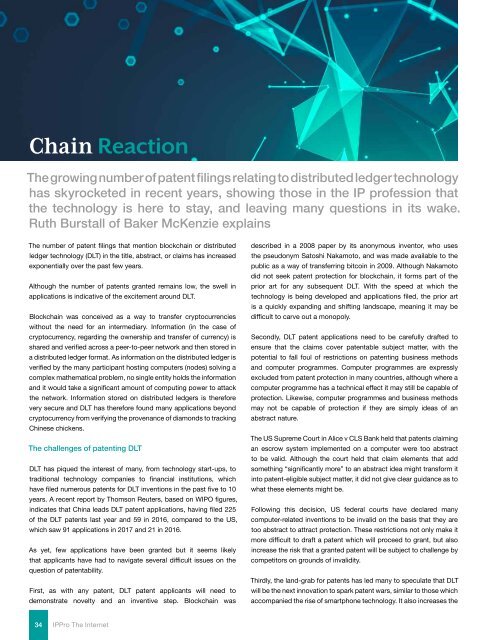IPPro Issue 002
IPPro is the go-to industry publication for news, views, and opinion on patent practice, law and management. The fortnightly publication and accompanying website - the only free-to-read intellectual property resource around - cover the full spectrum of IP law globally, including prosecution, litigation, licensing, management and technology.
IPPro is the go-to industry publication for news, views, and opinion on patent practice, law and management. The fortnightly publication and accompanying website - the only free-to-read intellectual property resource around - cover the full spectrum of IP law globally, including prosecution, litigation, licensing, management and technology.
Create successful ePaper yourself
Turn your PDF publications into a flip-book with our unique Google optimized e-Paper software.
Blockchain Patents<br />
Chain Reaction<br />
The growing number of patent filings relating to distributed ledger technology<br />
has skyrocketed in recent years, showing those in the IP profession that<br />
the technology is here to stay, and leaving many questions in its wake.<br />
Ruth Burstall of Baker McKenzie explains<br />
The number of patent filings that mention blockchain or distributed<br />
ledger technology (DLT) in the title, abstract, or claims has increased<br />
exponentially over the past few years.<br />
Although the number of patents granted remains low, the swell in<br />
applications is indicative of the excitement around DLT.<br />
Blockchain was conceived as a way to transfer cryptocurrencies<br />
without the need for an intermediary. Information (in the case of<br />
cryptocurrency, regarding the ownership and transfer of currency) is<br />
shared and verified across a peer-to-peer network and then stored in<br />
a distributed ledger format. As information on the distributed ledger is<br />
verified by the many participant hosting computers (nodes) solving a<br />
complex mathematical problem, no single entity holds the information<br />
and it would take a significant amount of computing power to attack<br />
the network. Information stored on distributed ledgers is therefore<br />
very secure and DLT has therefore found many applications beyond<br />
cryptocurrency from verifying the provenance of diamonds to tracking<br />
Chinese chickens.<br />
The challenges of patenting DLT<br />
DLT has piqued the interest of many, from technology start-ups, to<br />
traditional technology companies to financial institutions, which<br />
have filed numerous patents for DLT inventions in the past five to 10<br />
years. A recent report by Thomson Reuters, based on WIPO figures,<br />
indicates that China leads DLT patent applications, having filed 225<br />
of the DLT patents last year and 59 in 2016, compared to the US,<br />
which saw 91 applications in 2017 and 21 in 2016.<br />
As yet, few applications have been granted but it seems likely<br />
that applicants have had to navigate several difficult issues on the<br />
question of patentability.<br />
First, as with any patent, DLT patent applicants will need to<br />
demonstrate novelty and an inventive step. Blockchain was<br />
described in a 2008 paper by its anonymous inventor, who uses<br />
the pseudonym Satoshi Nakamoto, and was made available to the<br />
public as a way of transferring bitcoin in 2009. Although Nakamoto<br />
did not seek patent protection for blockchain, it forms part of the<br />
prior art for any subsequent DLT. With the speed at which the<br />
technology is being developed and applications filed, the prior art<br />
is a quickly expanding and shifting landscape, meaning it may be<br />
difficult to carve out a monopoly.<br />
Secondly, DLT patent applications need to be carefully drafted to<br />
ensure that the claims cover patentable subject matter, with the<br />
potential to fall foul of restrictions on patenting business methods<br />
and computer programmes. Computer programmes are expressly<br />
excluded from patent protection in many countries, although where a<br />
computer programme has a technical effect it may still be capable of<br />
protection. Likewise, computer programmes and business methods<br />
may not be capable of protection if they are simply ideas of an<br />
abstract nature.<br />
The US Supreme Court in Alice v CLS Bank held that patents claiming<br />
an escrow system implemented on a computer were too abstract<br />
to be valid. Although the court held that claim elements that add<br />
something “significantly more” to an abstract idea might transform it<br />
into patent-eligible subject matter, it did not give clear guidance as to<br />
what these elements might be.<br />
Following this decision, US federal courts have declared many<br />
computer-related inventions to be invalid on the basis that they are<br />
too abstract to attract protection. These restrictions not only make it<br />
more difficult to draft a patent which will proceed to grant, but also<br />
increase the risk that a granted patent will be subject to challenge by<br />
competitors on grounds of invalidity.<br />
Thirdly, the land-grab for patents has led many to speculate that DLT<br />
will be the next innovation to spark patent wars, similar to those which<br />
accompanied the rise of smartphone technology. It also increases the<br />
risk of so-called patent trolls—those whose business model is based<br />
on applying for or purchasing patents, then demanding royalties or<br />
suing for their use, rather than operating the inventions.<br />
Patent litigation is extremely expensive and for many pure-play DLT<br />
initiatives, patent litigation would require them to ‘bet the company’ on<br />
the result. The Blockchain Intellectual Property Council, established<br />
by the Digital Chamber of Commerce, a US advocacy group which<br />
promotes the emerging DLT industry, already warned in 2017 that the<br />
exponential rise in patent filings creates a high risk of IP abuse and<br />
has made helping DLT developers to manage this risk a key element<br />
of its strategy.<br />
The Chinese Ministry of Information Technology and the European<br />
Commission are already reportedly working on blockchain standards,<br />
and this is likely to lead to the emergence of Standard Essential<br />
Patents (SEPs). SEPs must be licensed on fair, reasonable and nondiscriminatory<br />
(FRAND) terms.<br />
Alternative approaches<br />
While there has been something of a gold rush to patent DLT-related<br />
innovations, there are different schools of thought as to whether filing<br />
patents is the correct way to protect DLT, and not all DLT developers<br />
are applying for patents. As a practical matter, for some start-ups, the<br />
cost of filing patent applications and the delay that the application<br />
process may introduce in getting a technology to market may be<br />
prohibitive. These companies may rely on trade secret protection<br />
in preference to patents, but, for companies seeking investment,<br />
applying for a registered patent and related monopoly may be a<br />
prerequisite to securing funding.<br />
Some think that developing DLT on an open source basis will be<br />
the best way to support the success of the technology by allowing<br />
interoperability of developments. For example, the Hyperledger<br />
Project established by Linux in 2015 aims to support collaborative<br />
development of DLT. Another approach has been to establish patent<br />
pools which allow the cross-licensing of patents. Some developers<br />
may take a hybrid approach—applying for patents on technology and<br />
then licensing them under open source licences.<br />
While we can expect the trend of<br />
high numbers of patent filings on the<br />
technology to continue it will probably<br />
not be long before some of the issues<br />
discussed above start to emerge<br />
What can blockchain do for patents?<br />
Whichever approach is taken to protecting DLT innovation, some are<br />
already flipping the question of what patents can do for DLT on its<br />
head and instead asking what can DLT do for patents?<br />
With various governments exploring the application of DLT for land<br />
registries, it is not beyond the realms of possibility that DLT could<br />
also be adopted as a way of registering and recording transfers and<br />
licences of patents and other IP rights. The European Parliamentary<br />
Research Service identified in a 2017 report that digital rights<br />
management and smart contracts are potential use cases of DLT.<br />
Many DLT start ups are already focusing on the application of DLT<br />
in recording the creation and transfer of unregistered rights such as<br />
copyright in music. DLT could also be used to defensively publish<br />
technologies as prior art to prevent others from obtaining a patent<br />
over such technologies.<br />
Although it is currently possible to record patents with customs<br />
authorities and to request that they detain and destroy infringing<br />
products, it is often difficult for customs authorities to tell whether<br />
products are indeed infringing. As DLT allows the secure recordal<br />
of information about a product’s provenance and the steps it has<br />
taken through the supply chain, it has huge potential in helping to<br />
enforce against the import of patent-infringing goods at customs<br />
borders. There are already examples of scannable chips or tags being<br />
embedded in products which interface with information recorded on<br />
blockchain to verify the authenticity of products. If customs authorities<br />
had access to technology which allowed them to scan such tags, this<br />
would greatly assist them in identifying counterfeit products.<br />
The interest of government bodies in DLT and the move towards<br />
creating standards suggests that this technology is here to stay.<br />
While we can expect the trend of high numbers of patent filings on<br />
the technology to continue it will probably not be long before some<br />
of the issues discussed above start to emerge. Exactly how it will<br />
transform the way we live and work remains to be seen, but DLT<br />
developments over the next few years should certainly be watched<br />
with interest by the IP community. <strong>IPPro</strong><br />
Ruth Burstall, senior associate, Baker McKenzie<br />
34 <strong>IPPro</strong> The Internet www.ipprotheinternet.com 35





